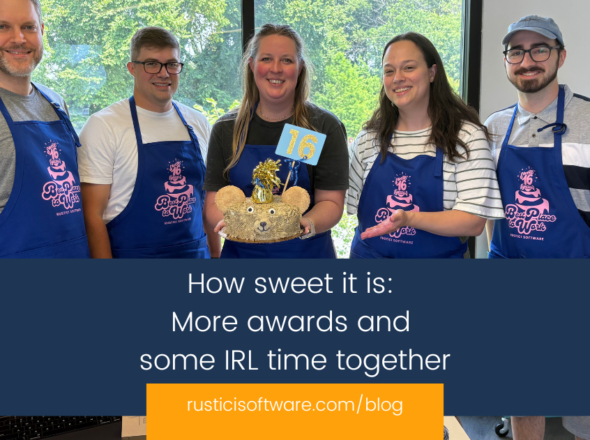At Rustici, we’ve always prided ourselves on our customer service. Even from its early days, the focus for our customer support team has been one word: delight. In fact, the internal name for the team — what shows up on my pay stub — is Delight.
When I joined the team six years ago, I have to admit this word made me a bit uncomfortable. It felt a bit . . . over-the-top. I had certainly been ‘satisfied’ in the past with various customer support interactions, but ‘delighted’? Not really.
It didn’t take long, though, for me to see that maybe this wasn’t just a marketing thing. Delight was not just a frontline support thing — everyone was actively trying to provide an exceptional experience, from pre-sales to implementation to long-term support. Even the many hundreds of people every week who ask us questions, but may never even buy our products, are treated with care and respect.
And when you see customer comments like this, you know we must be hitting our mark:
“Thanks very much for your help troubleshooting. Even though the issue had nothing to do with your product, it’s refreshing to have a company support its customer this way.“
“Rustici is the highball. Responsive and knowledgeable. That combination over time, with great consistency, is exceptional.”
“You are all gods. Your team is fantastic and I want to take them all skiing in New Zealand now…”
What is it though, that leads to delighting a customer like this? I see that there are a couple of main things that help us keep our focus in the right places when helping our customers.
Seek first to understand
We work with a wide range of people, some with very little technical background, and some that are senior developers working on integrating with our products. On top of that, our customers come from all over the world, and English may not be their first language.
Our first goal with any ticket is to make sure we’re understanding what is being said, and also what is not said. That last part is important, as oftentimes the actual problem that needs to be solved may not be precisely what the customer is asking initially.
If we just quickly paste in an answer based on a few key words, we may completely miss the point, and waste not only our own time, but the customer’s as well. How many bad support experiences have you had where the main problem was just that the person on the other end made no effort to really understand what you needed before answering?
We don’t want to just give them the fastest answer; we want to give them the best answer, even if it means a bit more work.
Have empathy
On the other side of every email, Zendesk ticket, or Basecamp thread that we receive, there is a living, breathing person who just wants to get their work done. They’d probably rather not have to contact us, but they’ve run into something that only we can help with. Maybe they have a learning standards question they can’t answer, an error message they don’t understand, or an idea for a feature they want to add to their product, but just aren’t sure how to do it. Sometimes the issue at hand isn’t even something with one of our products.
Their question to us represents only a tiny slice of their day, but maybe they can’t move on to the hundred other things on their to-do list until they figure this one thing out. That can be a stressful place to be. Accepting our role in their success helps motivate us to get them to the finish line as quickly and painlessly as possible.
And in those times where maybe their tone isn’t quite as nice as it could be? We can cut them a little slack.
Be honest
Let’s be honest: every piece of software has bugs (except yours, of course). When a customer inevitably finds that bug, how do you handle it? It can be difficult to admit mistakes, but trying to hide or paper over our product shortcomings can often just prolong the issue and lead to a lack of trust that harms our relationship with the customer.
While everyone would love to have the software just work the first time, I think most people understand that things happen. Nobody’s perfect. When you can freely discuss what is happening, then you can move immediately towards finding a workaround for the short-term, and a timeline for a full resolution.
Sometimes, though, there may not be a great workaround, or the dev team may not have the resources to implement the proposed change immediately. Having an open conversation with the customer about what’s possible and what the next steps are is often enough to help them communicate effectively with their own stakeholders and feel good about the interaction.
The trust a customer has that we’re playing it straight impacts every future interaction they have with us. And as your parents may have told you when you broke that vase as a child: trust is the one thing that can’t easily be put back together once it’s broken.
Conclusion
None of these are earth-shattering insights, but in the daily grind of customer support, it can be easy to lose sight of them. At the end of the day, the main goal is: treat people as real people, not just as tickets to solve or sales to close. Do that, and delight will follow (though maybe not skiing trips to New Zealand)!
We’re hiring!
With the increase in online learning and training due to the pandemic, many of our customers have seen record numbers of learners come onboard. This influx of new learners and desire for eLearning solutions has brought an increase in support volume for us as well.
If you’ve ever dreamed of working alongside the famous (okay, SCORM famous) Joe Donnelly and his brother Ryan, today is your lucky day! We’re looking to bring in a third frontline support person to help them make sure that we can continue delighting our customers in the future. If you’re interested, check out our job listing here.


